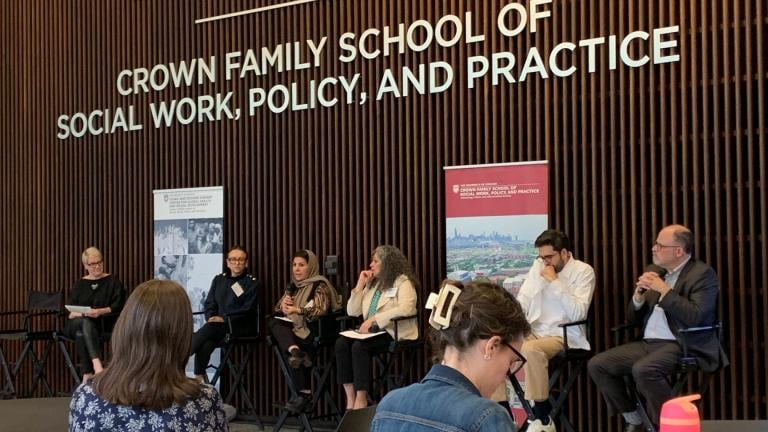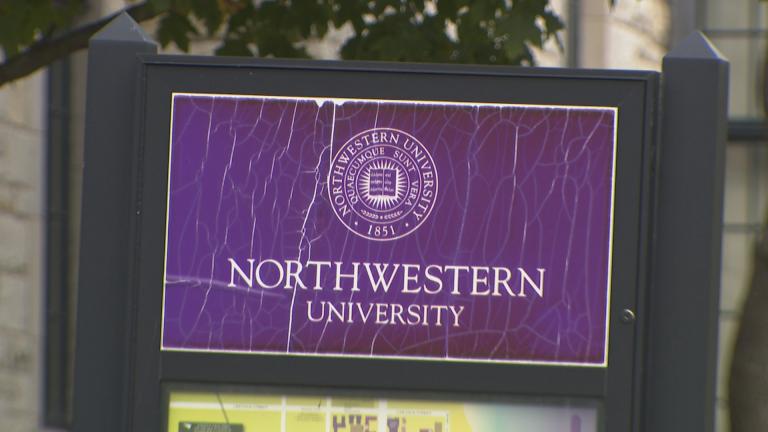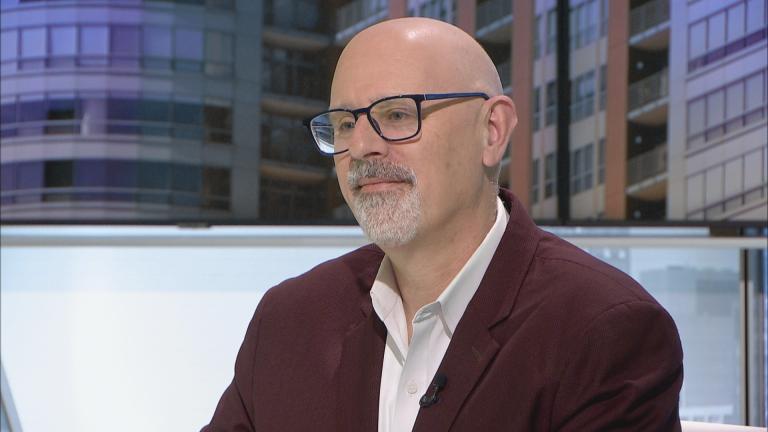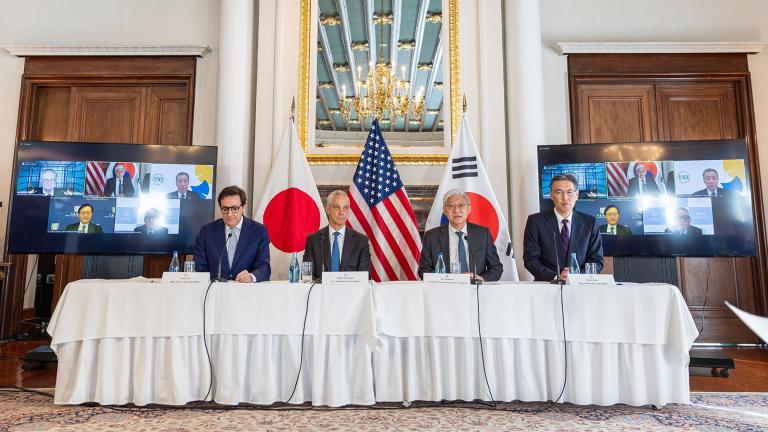“Oppenheimer,” the much-anticipated blockbuster from Batman director Christopher Nolan, hits movie theaters this week.
The story has deep connections to Chicago — specifically the University of Chicago — and the Manhattan Project that led to the development of the first atomic bomb.
Below is a Q&A with John Mark Hansen, professor of political science at the University of Chicago who has done extensive research on the birth of the nuclear age in Hyde Park’s “atomic village.”
(The interview has been edited for length and clarity.)
WTTW News: How did Chicago come to be the epicenter of research to make a self-sustaining nuclear reaction — the first step toward making an atomic bomb?
John Mark Hansen: Well, it was largely happenstance. The happenstance was that when the authorities in Washington who had been working on the development of nuclear power after the creation of the Manhattan Project in 1939, they decided that they would designate the first stage in the project to be under the direction of Arthur Compton, who was a professor of physics here at the University of Chicago and Nobel laureate, the chair of the physics department and the dean of the physical sciences division. And it was Compton then who within a month or so made the decision to gather all of the people he needed for that first stage of the project in Chicago. And so he was the one who asked Fermi and his group to come to Chicago.
Tell me a little bit about why Compton, because obviously, there are so many names that we are familiar with. We’re familiar with Oppenheimer. Obviously, we’re familiar with the Fermi. I don’t think as many people would know Compton. Why was Compton the man designated to get this project off the ground?
Hansen: Well, Compton was part of a group of physicists who were involved in an earlier project called the Uranium Project. He was asked by the government authorities in 1941 to produce a report about the feasibility of creating an atomic weapon and what the timetable would look like. So he was the chair of that committee, and I think it was kind of a natural extension then to ask him to be the one to lead it.
You’ve written about Hyde Park’s “atomic village.” Did the scientists talk about it in those terms at the time or is that something applied in retrospect? Is that how they thought of themselves?
Hansen: No, not really. That’s a name that I have given it in retrospect. You know, there were atomic villages that were built at Oak Ridge in Tennessee, at Hanford, in Washington and at Los Alamos in New Mexico. What I thought interesting about the group of scientists assembled here was that they weren’t segregated off from the rest of society the way they were at the other three sites. They lived out in the community and they did their work on a college campus not in a specially designed laboratory.
I can understand why they isolated the folks at Los Alamos and the other places you mentioned for security reasons. So why didn’t they do that in terms of the folks who were working in Chicago? It just seems like it would be a huge security risk.
Hansen: Well, part of it was just that they needed to get this going fast and they didn’t have anything built yet. So that’s one answer. Another answer is that they had originally, or Compton himself had originally wanted, to build the nuclear reactor that achieved the first sustainable chain reaction in 1942 — he had originally wanted to put that out at in part of the Argonne Woods Forest Preserve out in Palos Park. But the contractor didn’t get it done on time. And so it ended up being done under the West Grandstand of Stagg Field here on the campus just because they didn’t want to further delay the project.
Did all of the scientists who were working on the project have a clear notion that the end goal was to create a weapon?
Hansen: Every scientist who had a significant responsibility knew that that was the end point.
So after the first chain reaction had been achieved in Chicago, did many of the folks who were working in Chicago, were they transferred to Los Alamos?
Hansen: Yes. So a significant number were and there was a group that went to Oak Ridge, there was a group that went to Hanford and there was a group that went to Los Alamos. Oftentimes, on the way to Los Alamos, having been either at Oak Ridge or at Hanford in between.
It seems a very short period of development to go from that first chain reaction to within, I think it was 2.5 years, the Trinity test. How was that possible? Was it the fact that the government was just throwing so much in terms of personnel and money at this project?
Hansen: Well, a big part of it was that there was no expense that was spared in developing the bomb. But I would also say that Compton in his report about the timetable to the development of the bomb pretty much called it exactly right. He said that the first self-sustaining nuclear reaction could probably be achieved by early 1943 and the first battlefield weapons by sometime in 1945. So, it was anticipated even years in advance that that would be about the amount of time that would be required.
Obviously Oppenheimer himself was famously conflicted about this power he had helped to develop. Was that shared by many of his colleagues? I assume there was a range of opinions — they had achieved this incredible objective and created a weapon that ultimately did end the war. How did they feel about it?
Hansen: Well, as one might imagine, I think that there were differences in the degree to which the scientists who were involved in it felt conflicted. There were many scientists who were involved in the project who wish that we’d gotten there earlier so that the bomb might have played a role in ending the war in Europe sooner. A large number of the scientists in fact emigrated from Europe, many of them Germans who had been forced out of Germany by the Nazi regime. Many of them were Jewish and had relatives who perished and certainly friends who perished in the Holocaust. You know, on the other side, there were many scientists who were concerned not so much about having participated in the development of the bomb but not having any control over how that knowledge and how that science would be used.
So here at the Metallurgical Lab at the University of Chicago, starting in 1944, there was a major effort by the scientists to begin to sound alarms and to convince the government to begin to think about how to put in place controls over the development and use of nuclear energy. There was a lot of concern even in 1944 about the prospect of an arms race once it became known that there was such a thing as an atomic bomb. And that led in 1945 and into 1946 into a sustained effort on the part of the atomic scientists led by the people here at the Met lab to create a governance structure for nuclear energy development that would be accountable to democratically elected public officials and be accountable to the public.
In terms of the film, I don’t know whether you’ve had a chance to see it yet, but do you think the interest it has generated in the story of Oppenheimer and the development of the atomic bomb — is it a good thing that people are relearning this history?
Hansen: I think so. It certainly is going to raise awareness of the continuing issues of nuclear proliferation and of the prospects of nuclear confrontations — probably not in the places that we once thought about, but rather in places like South Asia or in East Asia. So that’s one thing I. I think the other thing it really puts on the agenda is the questions about the dangers in the development of technology and how one contains those dangers. And those are still with us. You know there are lots of technologies out there that could have far-reaching social effects and sort of bringing back to the public’s attention the way in which nuclear scientists really wrestled with the dictates of their conscience at the same time that they were developing these technologies I think that has many lessons for us as well.
The Bulletin of the Atomic Scientists and other organizations are hosting a special showing of “Oppenheimer” at the Music Box Theatre on July 29, followed by a post-movie panel conversation.








